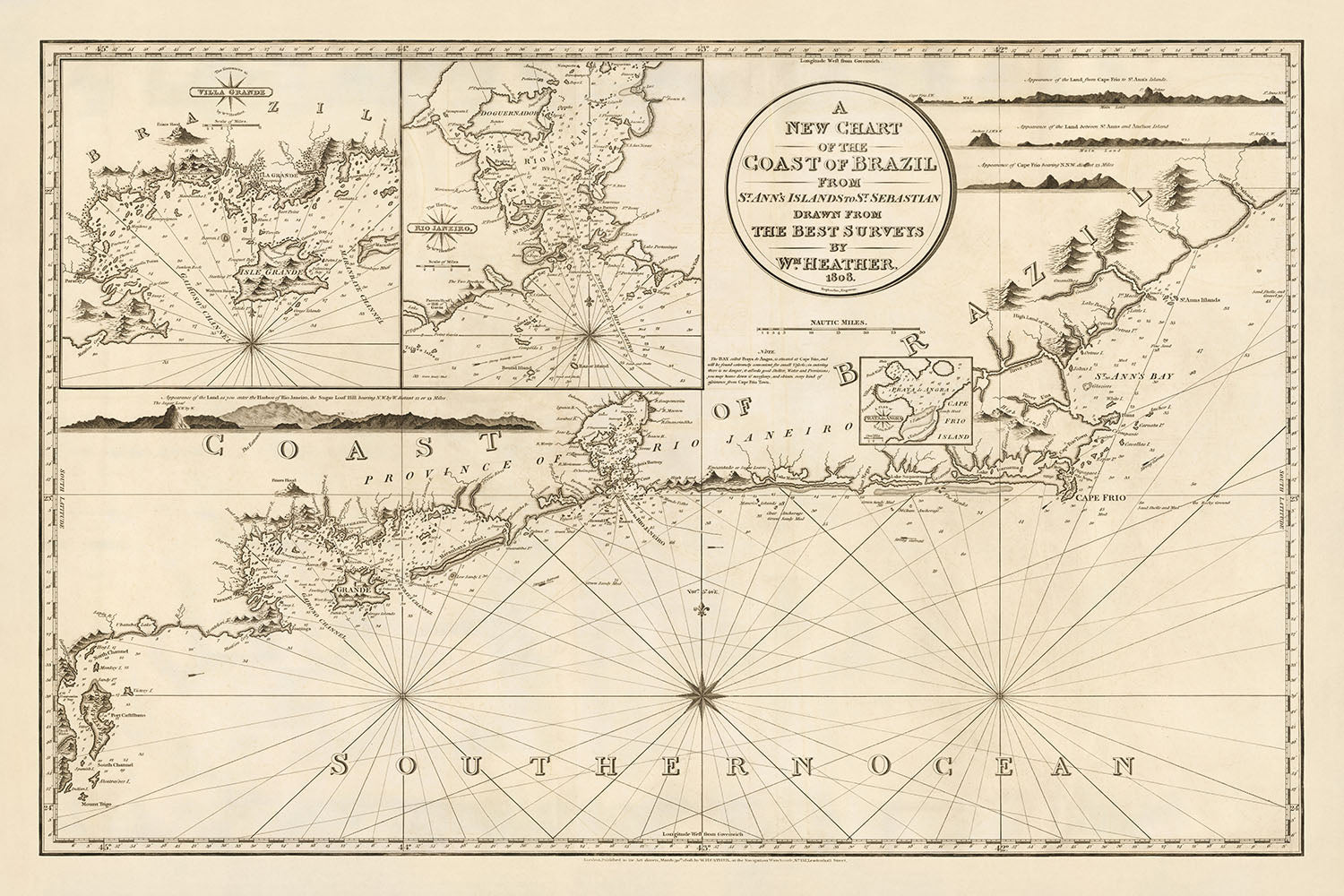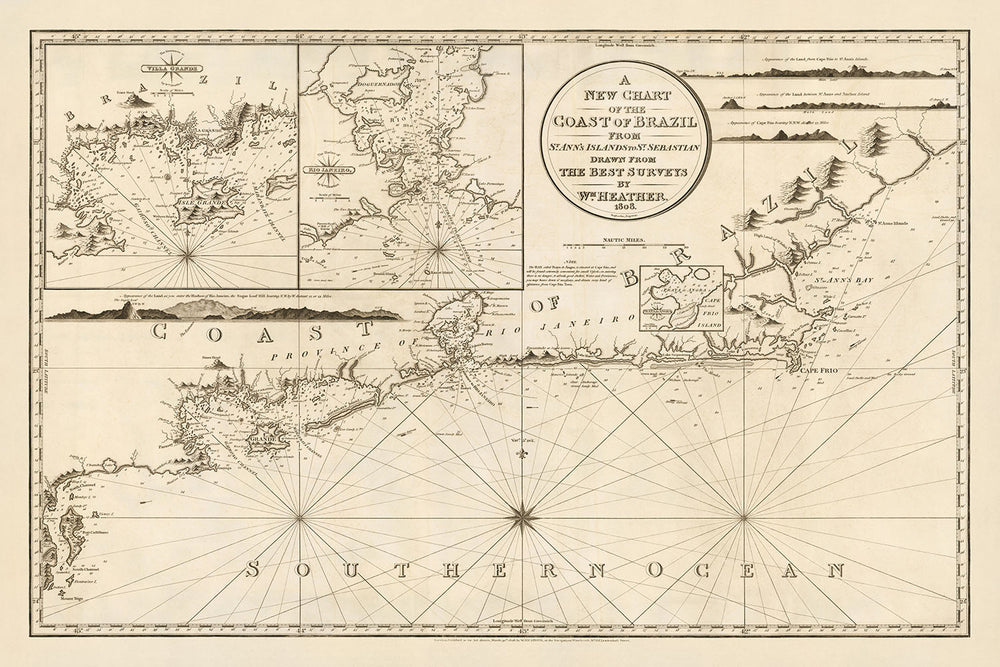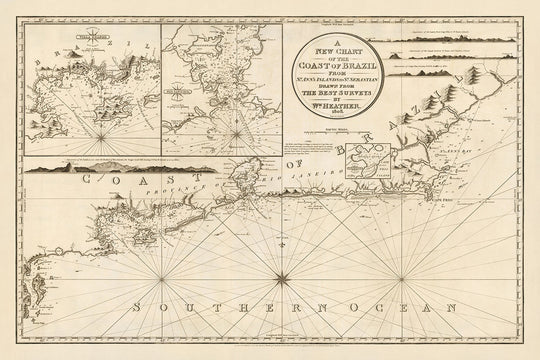- Handmade locally. No import duty or tax
- FREE Delivery by Christmas
- Love it or your money back (90 days)
- Questions? WhatsApp me any time
Own a piece of history
5,000+ 5 star reviews


A New Chart of the Coast of Brazil: A Masterpiece of Early 19th Century Cartography
This exceptional sea chart, titled "A New Chart of the Coast of Brazil From St. Ann's Island to St. Sebastian," is a testament to the meticulous work of William Heather, a renowned British hydrographer and cartographer of the early 19th century. Created in 1802 and published in 1808, this chart captures a pivotal moment in maritime history, coinciding with the year the Portuguese royal family relocated to Rio de Janeiro amidst the Napoleonic Wars. Heather, known for his precise and detailed nautical charts, utilized surveys conducted by the Portuguese Navy, offering an unparalleled accuracy in depicting the Brazilian coastline during a time when the region was a crucial hub for both British and American maritime activities.
Detailed Depictions and Strategic Insights
The chart is meticulously detailed, showcasing the eastern coast of South America from São Luís down to Rio de Janeiro. It features an array of geographical annotations including the names of coastal towns, rivers, and strategic locations such as European forts and Amerindian tribal areas. This level of detail not only provided invaluable information for navigation but also reflected the geopolitical interests of the era, highlighting areas of economic and military significance. The inclusion of depth measurements, sandbars, and other navigational hazards further underscores the chart’s practical utility for mariners of the time.
Artistic and Functional Elements
Beyond its navigational utility, the chart is a work of art. It is oriented with north at the top and employs a subdued, earth-toned color palette that enhances its readability and aesthetic appeal. The inclusion of a compass rose and scale bars in both statute miles and leagues exemplifies Heather’s commitment to accuracy and detail. These elements, combined with the large-format design, make the chart not only a valuable tool for 19th-century sailors but also a captivating historical artifact.
Historical Context and Its Implications
The chart’s creation was significantly influenced by the socio-political dynamics of the early 1800s. The strategic importance of Brazil as a resupply point for vessels navigating around Cape Horn, and as a trade link between Britain and Portugal, is intricately captured in this chart. This was particularly crucial during a time when maritime routes were vital for economic survival and military logistics. The chart not only guided mariners but also served as a strategic map for understanding the complexities of Atlantic navigation and international relations.
A Legacy Captured in Cartography
William Heather’s chart is more than just a navigational aid; it is a rich historical document that offers a glimpse into the maritime challenges and achievements of the early 19th century. For collectors and enthusiasts of maritime history, this chart is a prized possession that encapsulates the essence of an era where sea travel was both perilous and pivotal. It stands as a tribute to the skill and dedication of cartographers like Heather, who played a critical role in shaping the understanding of the world’s most treacherous waters and the narratives of those who navigated them.
Notable Places on This Map
- Barra Grande
- Rio Grande
- Porto Seguro
- Abrolhos Shoals
- Bahia de Todos os Santos
- Itaparica Island
- Rio Vermelho
- Salvador
- Cape St. Augustine
- Rio Doce
- Espirito Santo
- Cape Frio
- Rio de Janeiro
- Ilha Grande
- Angra dos Reis
- Parati
- Ubatuba
- Sao Sebastiao
Notable Features & Landmarks
- The map is oriented with north at the top.
- Shows the eastern coast of South America, from São Luís to Rio de Janeiro.
- Includes the names of coastal towns, rivers, and islands.
- Shows the locations of several Amerindian tribes.
- Shows the locations of several European forts and settlements.
- Includes a scale bar in statute miles and leagues.
- Features a compass rose.
- Dated 1802.
- Created by William Heather.
- Published by the British Admiralty.
Historical and Design Context
- Created by William Heather, a British hydrographer and cartographer known for his detailed charts of the Atlantic Ocean and the Caribbean Sea.
- Based on surveys conducted under the auspices of the Portuguese Navy around the turn of the century.
- Useful for mariners during the early 19th century, particularly for navigating the strategic Brazilian coastlines frequented by both British and American ships.
- Coincides with the year the Portuguese royal family relocated to Rio de Janeiro, highlighting its significance during the Napoleonic Wars.
- First accurate general chart of Rio de Janeiro Harbor, reflecting its importance in maritime navigation and trade during this period.
Please double check the images to make sure that a specific town or place is shown on this map. You can also get in touch and ask us to check the map for you.
This map looks great at every size, but I always recommend going for a larger size if you have space. That way you can easily make out all of the details.
This map looks amazing at sizes all the way up to 100in (250cm). If you are looking for a larger map, please get in touch.
The model in the listing images is holding the 24x36in (60x90cm) version of this map.
The fifth listing image shows an example of my map personalisation service.
If you’re looking for something slightly different, check out my collection of the best old maps to see if something else catches your eye.
Please contact me to check if a certain location, landmark or feature is shown on this map.
This would make a wonderful birthday, Christmas, Father's Day, work leaving, anniversary or housewarming gift for someone from the areas covered by this map.
This map is available as a giclée print on acid free archival matte paper, or you can buy it framed. The frame is a nice, simple black frame that suits most aesthetics. Please get in touch if you'd like a different frame colour or material. My frames are glazed with super-clear museum-grade acrylic (perspex/acrylite), which is significantly less reflective than glass, safer, and will always arrive in perfect condition.
This map is also available as a float framed canvas, sometimes known as a shadow gap framed canvas or canvas floater. The map is printed on artist's cotton canvas and then stretched over a handmade box frame. We then "float" the canvas inside a wooden frame, which is available in a range of colours (black, dark brown, oak, antique gold and white). This is a wonderful way to present a map without glazing in front. See some examples of float framed canvas maps and explore the differences between my different finishes.
For something truly unique, this map is also available in "Unique 3D", our trademarked process that dramatically transforms the map so that it has a wonderful sense of depth. We combine the original map with detailed topography and elevation data, so that mountains and the terrain really "pop". For more info and examples of 3D maps, check my Unique 3D page.
For most orders, delivery time is about 3 working days. Personalised and customised products take longer, as I have to do the personalisation and send it to you for approval, which usually takes 1 or 2 days.
Please note that very large framed orders usually take longer to make and deliver.
If you need your order to arrive by a certain date, please contact me before you order so that we can find the best way of making sure you get your order in time.
I print and frame maps and artwork in 23 countries around the world. This means your order will be made locally, which cuts down on delivery time and ensures that it won't be damaged during delivery. You'll never pay customs or import duty, and we'll put less CO2 into the air.
All of my maps and art prints are well packaged and sent in a rugged tube if unframed, or surrounded by foam if framed.
I try to send out all orders within 1 or 2 days of receiving your order, though some products (like face masks, mugs and tote bags) can take longer to make.
If you select Express Delivery at checkout your order we will prioritise your order and send it out by 1-day courier (Fedex, DHL, UPS, Parcelforce).
Next Day delivery is also available in some countries (US, UK, Singapore, UAE) but please try to order early in the day so that we can get it sent out on time.
My standard frame is a gallery style black ash hardwood frame. It is simple and quite modern looking. My standard frame is around 20mm (0.8in) wide.
I use super-clear acrylic (perspex/acrylite) for the frame glass. It's lighter and safer than glass - and it looks better, as the reflectivity is lower.
Six standard frame colours are available for free (black, dark brown, dark grey, oak, white and antique gold). Custom framing and mounting/matting is available if you're looking for something else.
Most maps, art and illustrations are also available as a framed canvas. We use matte (not shiny) cotton canvas, stretch it over a sustainably sourced box wood frame, and then 'float' the piece within a wood frame. The end result is quite beautiful, and there's no glazing to get in the way.
All frames are provided "ready to hang", with either a string or brackets on the back. Very large frames will have heavy duty hanging plates and/or a mounting baton. If you have any questions, please get in touch.
See some examples of my framed maps and framed canvas maps.
Alternatively, I can also supply old maps and artwork on canvas, foam board, cotton rag and other materials.
If you want to frame your map or artwork yourself, please read my size guide first.
My maps are extremely high quality reproductions of original maps.
I source original, rare maps from libraries, auction houses and private collections around the world, restore them at my London workshop, and then use specialist giclée inks and printers to create beautiful maps that look even better than the original.
My maps are printed on acid-free archival matte (not glossy) paper that feels very high quality and almost like card. In technical terms the paper weight/thickness is 10mil/200gsm. It's perfect for framing.
I print with Epson ultrachrome giclée UV fade resistant pigment inks - some of the best inks you can find.
I can also make maps on canvas, cotton rag and other exotic materials.
Learn more about The Unique Maps Co.
Map personalisation
If you're looking for the perfect anniversary or housewarming gift, I can personalise your map to make it truly unique. For example, I can add a short message, or highlight an important location, or add your family's coat of arms.
The options are almost infinite. Please see my map personalisation page for some wonderful examples of what's possible.
To order a personalised map, select "personalise your map" before adding it to your basket.
Get in touch if you're looking for more complex customisations and personalisations.
Map ageing
I have been asked hundreds of times over the years by customers if they could buy a map that looks even older.
Well, now you can, by selecting Aged before you add a map to your basket.
All the product photos you see on this page show the map in its Original form. This is what the map looks like today.
If you select Aged, I will age your map by hand, using a special and unique process developed through years of studying old maps, talking to researchers to understand the chemistry of aging paper, and of course... lots of practice!
If you're unsure, stick to the Original colour of the map. If you want something a bit darker and older looking, go for Aged.
If you are not happy with your order for any reason, contact me and I'll get it fixed ASAP, free of charge. Please see my returns and refund policy for more information.
I am very confident you will like your restored map or art print. I have been doing this since 1984. I'm a 5-star Etsy seller. I have sold tens of thousands of maps and art prints and have over 5,000 real 5-star reviews. My work has been featured in interior design magazines, on the BBC, and on the walls of dozens of 5-star hotels.
I use a unique process to restore maps and artwork that is massively time consuming and labour intensive. Hunting down the original maps and illustrations can take months. I use state of the art and eye-wateringly expensive technology to scan and restore them. As a result, I guarantee my maps and art prints are a cut above the rest. I stand by my products and will always make sure you're 100% happy with what you receive.
Almost all of my maps and art prints look amazing at large sizes (200cm, 6.5ft+) and I can frame and deliver them to you as well, via special oversized courier. Contact me to discuss your specific needs.
Or try searching for something!















































